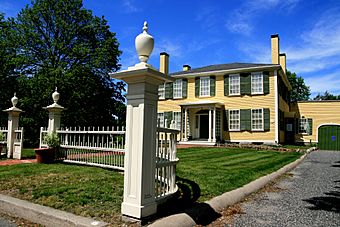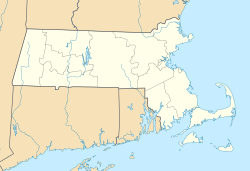Jackson Homestead facts for kids
Quick facts for kids |
|
|
Jackson Homestead
|
|

Jackson Homestead
|
|
| Location | Newton, Massachusetts |
|---|---|
| Built | 1809 |
| Architectural style | Federal |
| NRHP reference No. | 73000306 |
| Added to NRHP | June 4, 1973 |
The Jackson Homestead is a very old and special house located in Newton, Massachusetts. It's famous because it was a secret stop on the Underground Railroad before the American Civil War. This was a network of safe houses and routes that helped enslaved people find freedom.
The house was built in 1809 by Timothy Jackson. His son, William Jackson, lived there for many years. William was an abolitionist, meaning he worked to end slavery. He was also a politician who served in the United States Congress. The Jackson family lived in the house until 1932. Later, in 1949, the house was given to the city of Newton. In 1950, it became the Newton History Museum.
Contents
The Homestead's Early Days
How the Jackson Family Started in Newton
The story of the Jackson Homestead began in 1646. That year, Edward Jackson bought a large farm. It was about 500 acres and covered much of what is now Newton Corner and Newtonville.
Around 1670, Edward built the first house on this land. It was a "saltbox" style house. This meant it had two stories in the front and one in the back. The house was never painted, inside or out. It got its water from a well.
Building a New Home in 1809
In 1809, Major Timothy Jackson, a descendant of Edward, decided to build a new, more modern house. He designed it himself and helped with the building. This new house was much better than the old one. It had an indoor well and a laundry area. It also featured large fireplaces and a grand staircase. The new house had private bedrooms upstairs. This is the house we know today as the Jackson Homestead.
Changes by William Jackson
After Timothy Jackson passed away, his son William took over the homestead. William made some changes to the house. He adjusted the bedrooms to fit his large family. The house was painted yellow with cream trim and green shutters. This is the same color scheme you can see on the house today. Central heating was also added in the 1830s.
Modern Updates to the House
By the 1900s, the Jackson Homestead started using city water instead of its well. William's granddaughter, Louise Keith, led major updates. Modern plumbing was installed in the bathrooms and kitchen. These were connected to the city's sewer system. The wooden ceiling beams were made stronger with iron braces. Many new glass panels were put into the windows. The inside of the house was repainted. For the first time, the outside of the house was painted white.
Becoming a Museum
In 1949, Frances (Hatch) Paine gave the homestead to the City of Newton. She wanted it to be used for education and public purposes. The Homestead then became the City Museum. More changes were made, including a remodel of a part of the house in 1966.
The Jackson Homestead Today
Today, the Jackson Homestead is known as the Jackson Homestead and Museum. It is run by an organization called Historic Newton. Their goal is to share the stories of Newton's history. They also connect these local stories to bigger American history.
The museum has different exhibits. Some are permanent, and some change over time. These exhibits teach visitors about the history of Newton, Massachusetts. They also focus on the important role the house played in the Underground Railroad. The museum also keeps important historical documents and records.
On June 4, 1973, the Jackson Homestead was officially added to the National Register of Historic Places. This means it is recognized as an important historical site.
More to Explore



